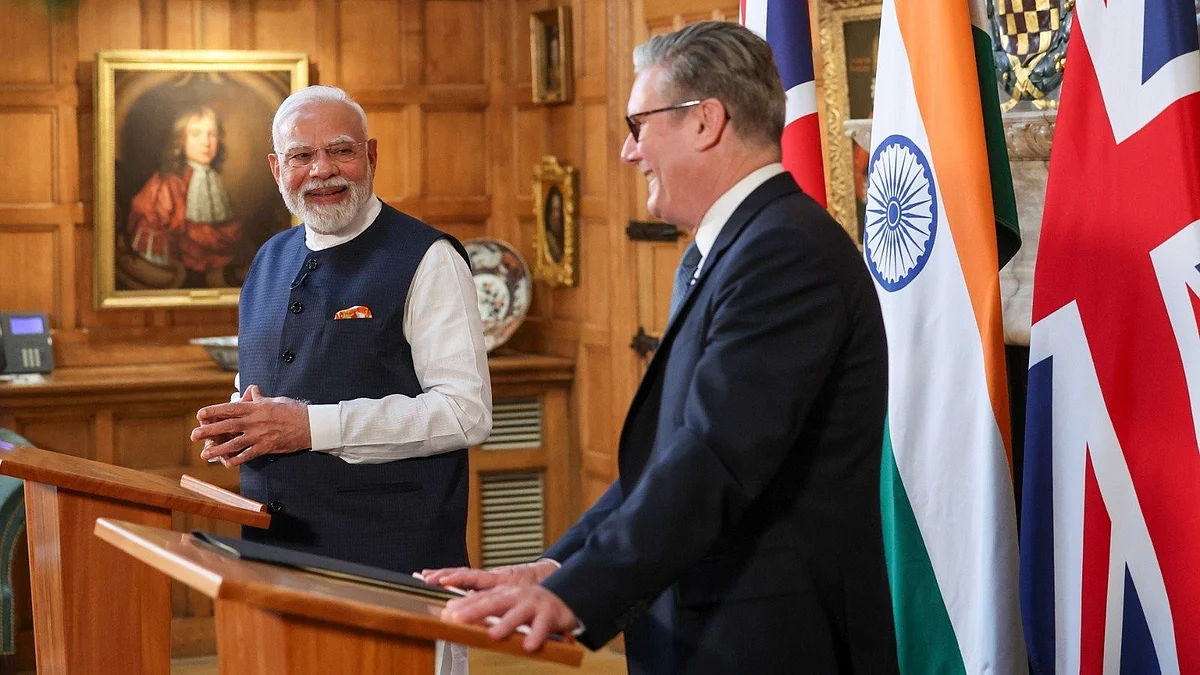UK trade deal signals shift in India’s strategy, sets tone for crucial US pact
Negotiations with Washington are currently on a tightrope, with both sides scrambling to meet a 1 August deadline

India’s newly signed free trade agreement (FTA) with the United Kingdom marks a significant recalibration of its global trade alliances, offering both economic promise and complex strategic challenges as it prepares for what could be its most consequential trade negotiation yet — with the United States.
Finalised earlier this year and formally signed on 24 July by Prime Minister Narendra Modi and UK Prime Minister Keir Starmer, the UK-India deal will slash tariffs on 85 per cent of British exports to India over the next decade. Products ranging from medical devices to aerospace parts are set to become more affordable for Indian consumers, while Indian exports such as garments, jewellery, and spices are expected to gain preferential access in the UK.
However, gains for both nations may come at the cost of other trade partners. An analysis of trade flows reveals that the FTA could erode the competitiveness of exports from key allies like the US, EU, and Japan.
For instance, US exporters — particularly in sectors like scrap metals, vehicle parts, contact lenses, and therapeutic equipment — stand to lose market share due to tariff disadvantages in India. Approximately $1.24 billion worth of US exports to India, or 3.2 per cent of its total, may now face tougher competition from the UK.
Japan and the EU are also vulnerable, with 2.2 per cent and 1.7 per cent of their exports to India respectively likely to be affected. Australia and Canada could see similar disruptions.
With trade between India and the UK currently pegged at $56 billion, the two nations are targeting to double this figure by 2030. A UK government study projects that the deal could add $15.7 billion to British exports by 2040, boosting its GDP by 0.13 percentage points.
Also Read: India-UK FTA: The good, the bad and the ugly
For India, the agreement reflects a shift in priorities: the pursuit of advanced industrial and medical technology access at lower costs, and stronger positioning in labour-intensive export sectors. It also presents a template for India’s ongoing trade talks with the European Union and, more pressingly, with the US.
Negotiations with Washington are currently on a tightrope, with both sides scrambling to meet an 1 August deadline. Unlike the structured UK talks, discussions with the US have been described as hurried and politically sensitive, particularly around agriculture.
While the UK deal saw India firmly exclude sensitive agricultural items such as dairy products, apples, and certain seeds from tariff concessions, similar lines are being drawn in US negotiations, especially as American officials push for access to genetically modified (GM) crops like corn and soya.
The Indian Coordination Committee of Farmers Movements has urged the government to entirely ring-fence agriculture in the US deal, arguing that domestic livelihoods must be prioritised. Given the current political climate, New Delhi is expected to maintain a cautious stance.
The contrasting structures of the two deals are also evident in tariff architecture. The UK pact is largely sector-driven, while the US deal is expected to focus on headline tariff numbers. India, which managed to reduce average tariffs on UK imports from 15per cent to 3 per cent, is now seeking a similarly favourable outcome from Washington.
Should the US offer tariff access in the 10–15 per cent range, matching or bettering the UK and Japan benchmarks, India may consider it a diplomatic win. However, any offer exceeding 15 per cent, or incorporating transhipment clauses similar to those applied to Vietnam, may be deemed unfavourable—particularly given the integrated nature of Indian exports, which often rely on inputs from countries like China.
India is also keen to avoid further complications related to sectoral tariffs already impacting its exports to the US — such as the 50 per cent duties on steel, aluminium, and copper — amid fears of additional levies linked to geopolitical tensions, including trade with Russia.
Worker mobility, another sensitive issue, received limited accommodation in the UK deal. Although an annual quota of 1,800 temporary work permits was granted for chefs, classical musicians and yoga instructors, broader commitments on professional migration and business visas were notably absent. These restrictions could influence the tone of the US negotiations, particularly in India’s efforts to secure more robust access for its services sector and IT professionals.
Still, the UK deal has delivered one important precedent: the agreement on social security coordination. Under the new Double Contributions Convention, employees temporarily working in each other’s countries for up to three years will contribute only to their home social security systems. While this may offer a cost-saving mechanism for Indian workers abroad, its actual implementation remains uncertain.
As India eyes deeper trade integration with major global economies, the UK agreement underscores both the potential and the pitfalls. While it opens new doors for technology transfer and market access, it also forces a realignment of India’s trade dependencies — particularly with the US, where the stakes are significantly higher.
The next few days of negotiation will determine whether India can leverage the UK deal as a stepping stone, or whether it risks being caught between competing global powers in a shifting economic order.
Follow us on: Facebook, Twitter, Google News, Instagram
Join our official telegram channel (@nationalherald) and stay updated with the latest headlines
